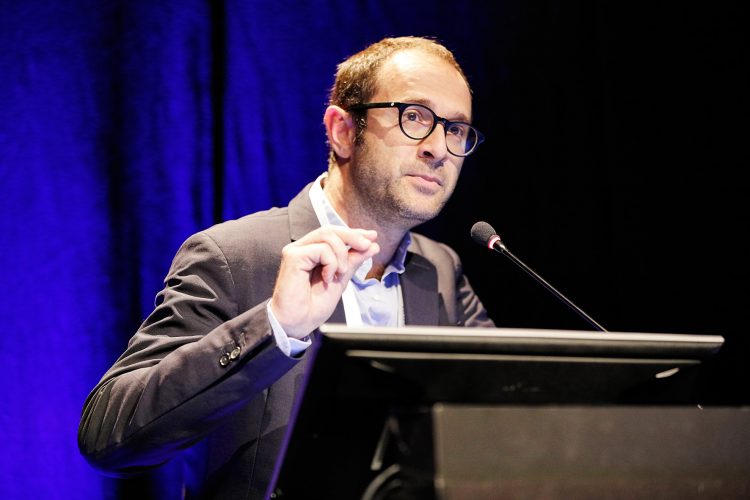How ageing can affect the cornea
Wide-ranging therapeutic consequences of corneal ageing

Dermot McGrath
Published: Wednesday, December 4, 2019
 Antoine Rousseau MD
Age-related changes in the cornea and ocular surface tissues have a major effect on vision and should be taken into account in many aspects of everyday clinical practice, according to Antoine Rousseau MD.
“Ageing affects us all but we don’t always consider the direct impact it has on the cornea and the wide-ranging therapeutic consequences relating to the process of ageing in the eye,” he told delegates attending the 10th EuCornea Congress in Paris.
Defined as an age-dependent or age-progressive decline in intrinsic physiological function and loss of adaptation, ageing affects the structure and function of the eye in multiple ways, said Dr Rousseau of Kremlin-Bicêtre Hospital in Paris. Corneal biomechanics, permeability and astigmatism, for example, are all impacted by the passage of time.
The ageing eye is also more susceptible to the damaging effects of ultraviolet radiation. The cornea and the lens absorb most UV-B rays, while UV-A radiation penetrates through the stroma and induces reactive oxygen species, which can lead to oxidative stress, inflammation and cellular damage, explained Dr Rousseau.
In terms of structural changes in the eye, some studies have shown a decrease in mid-peripheral and peripheral epithelial thickness over time, while there appears to be no correlation between stromal thickness and age. By contrast the epithelium basement membrane thickens over the course of a lifetime and the risk of dystrophy increases with age. Corneal nerve density has also been shown to decrease with age, said Dr Rousseau.
Ageing also plays a role in diseases such as Fuchs’ endothelial corneal dystrophy. Although the actual mechanism of cell loss is unknown, it has been hypothesised that UV-A may promote reactive oxygen species accumulation and oxidative stress with implications for cell survival and functionality.
Corneal permeability also increases with age, although the exact reason for this is still not fully understood.
“It is a matter of debate but we do know that ocular penetration is increased with age and should be taken into account when prescribing topical drugs to our patients,” he said.
Ageing should also be taken into account by glaucoma specialists because corneal biomechanics change with age and can have an impact on the
intraocular pressure.
“It is not easy to correlate this in clinical practice but we should at least keep it in mind,” said Dr Rousseau.
Ageing also needs to be taken into account after cataract surgery, with particular regard to epithelial defects in patients with basement membrane dystrophy. Age-related changes in corneal astigmatism may have consequences for the predictability of toric IOLs and need to be considered in long-term planning for the patient, he concluded.
Antoine Rousseau MD
Age-related changes in the cornea and ocular surface tissues have a major effect on vision and should be taken into account in many aspects of everyday clinical practice, according to Antoine Rousseau MD.
“Ageing affects us all but we don’t always consider the direct impact it has on the cornea and the wide-ranging therapeutic consequences relating to the process of ageing in the eye,” he told delegates attending the 10th EuCornea Congress in Paris.
Defined as an age-dependent or age-progressive decline in intrinsic physiological function and loss of adaptation, ageing affects the structure and function of the eye in multiple ways, said Dr Rousseau of Kremlin-Bicêtre Hospital in Paris. Corneal biomechanics, permeability and astigmatism, for example, are all impacted by the passage of time.
The ageing eye is also more susceptible to the damaging effects of ultraviolet radiation. The cornea and the lens absorb most UV-B rays, while UV-A radiation penetrates through the stroma and induces reactive oxygen species, which can lead to oxidative stress, inflammation and cellular damage, explained Dr Rousseau.
In terms of structural changes in the eye, some studies have shown a decrease in mid-peripheral and peripheral epithelial thickness over time, while there appears to be no correlation between stromal thickness and age. By contrast the epithelium basement membrane thickens over the course of a lifetime and the risk of dystrophy increases with age. Corneal nerve density has also been shown to decrease with age, said Dr Rousseau.
Ageing also plays a role in diseases such as Fuchs’ endothelial corneal dystrophy. Although the actual mechanism of cell loss is unknown, it has been hypothesised that UV-A may promote reactive oxygen species accumulation and oxidative stress with implications for cell survival and functionality.
Corneal permeability also increases with age, although the exact reason for this is still not fully understood.
“It is a matter of debate but we do know that ocular penetration is increased with age and should be taken into account when prescribing topical drugs to our patients,” he said.
Ageing should also be taken into account by glaucoma specialists because corneal biomechanics change with age and can have an impact on the
intraocular pressure.
“It is not easy to correlate this in clinical practice but we should at least keep it in mind,” said Dr Rousseau.
Ageing also needs to be taken into account after cataract surgery, with particular regard to epithelial defects in patients with basement membrane dystrophy. Age-related changes in corneal astigmatism may have consequences for the predictability of toric IOLs and need to be considered in long-term planning for the patient, he concluded.